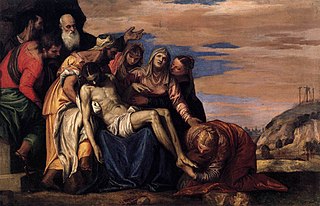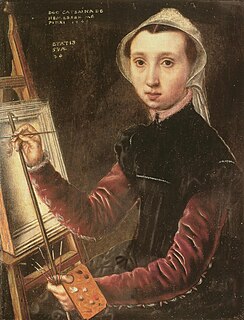 W
WThe Bevilacqua-Lazise Altarpiece is a 1548 oil on canvas painting by Paolo Veronese, now in Castelvecchio Museum in Verona. It was commissioned by the Bevilaqua-Lazise family for their funerary chapel in the church of San Fermo Maggiore in Verona. Two of the family are shown praying in the bottom corners, with John the Baptist and a bishop saint. An early work, it still shows heavy influence from Veronese's teacher Antonio Badile and Michele Sanmicheli.
 W
WEquestrian Portrait of Charles V is an oil-on-canvas painting by the Italian Renaissance artist Titian. Created between April and September 1548 while Titian was at the imperial court of Augsburg, it is a tribute to Charles V, Holy Roman Emperor, following his victory in the April 1547 Battle of Mühlberg against the Protestant armies.
 W
WLament over the Dead Christ is a c.1548 oil on canvas painting by Paolo Veronese, now in the Museo di Castelvecchio in Verona.
 W
WThe Miracle of the Slave is a painting by the Italian Renaissance artist Jacopo Tintoretto, and is now in the Gallerie dell'Accademia in Venice. It was originally commissioned for the Scuola Grande di San Marco, a confraternity in the city.
 W
WThe Portrait of Charles V is an oil on canvas portrait of Charles V, Holy Roman Emperor by Titian, painted in 1548. As with the Equestrian Portrait of Charles V, it was commissioned by Charles during Titian's stay at the imperial court at Augsburg. It is now in the Alte Pinakothek in Munich, Germany.
 W
WThe Portrait of Isabella of Portugal is an oil-on-canvas portrait of Isabella of Portugal, Holy Roman Empress by Titian dating to 1548. It was part of the Spanish royal collection and is now in the Museo del Prado in Madrid.
 W
WSelf-Portrait is a small painting executed in oil on oak in 1548 by the Flemish Renaissance artist Caterina van Hemessen when she was 20 years old. The painting earned her a considerable reputation during her lifetime and is significant not only for being an early modern female portrait but also for representing an artist in the act of painting. This was very unusual for the time; although self-portraits were common, only a few, like those of Albrecht Dürer (1471–1528), showed the artist's social position and everyday life. Artists of the time rarely directly referred to, much less showed the tools of their profession. Hemessen's portrait is one of the earliest in the Northern European tradition to show a painter not only with a brush but also a palette and easel. She inscribed it with the words: "I Caterina van Hemessen have painted myself / 1548 / Her aged 20".
 W
WThe Serravalle Altarpiece or Madonna and Child in Glory with Saint Andrew and Saint Peter is a painting by Titian, now in the church of Santa Maria Nova in Serravalle, for which it was commissioned.
 W
WSulsted Church, located in Sulsted, a small Danish town in northern Jutland, just north of Aalborg, was constructed ca. 1150-1200 and features a large number of frescos or kalkmalerier, all created in 1548 by Hans Maler from Randers.
 W
WThe Procuress is an oil-on-panel painting by the German Renaissance painter Lucas Cranach the Elder. The Procuress was painted in 1548, in Germany. The style of the painting is the Northern Renaissance, Renaissance of the northern Alps during the 15th century that influenced German painters. There are three characters depicted in the painting: the young man, who gives a bag of money to the procuress – the protagonist of the composition, and a young woman who will marry the man. The wicked appearance of the procuress creates a deleterious and ensnaring aura that captures the attention immediately. The painting is now housed in Georgian National Museum, in Tbilisi, Georgia. However, it had an exceptionally long and dangerous journey before getting back to the museum. The estimated value of The Procuress is more than $40 million.